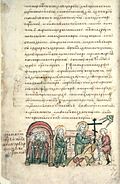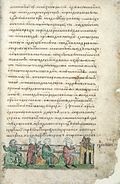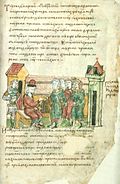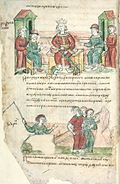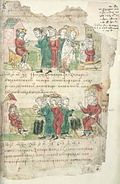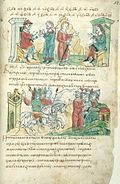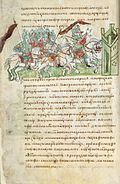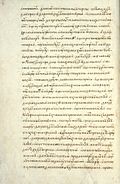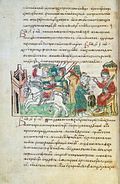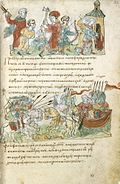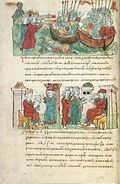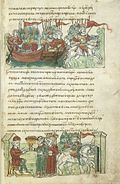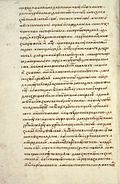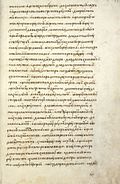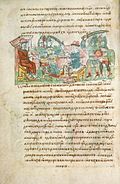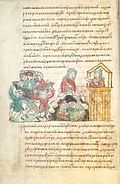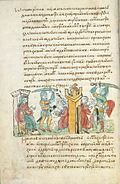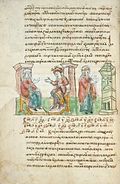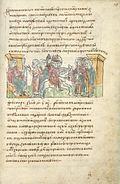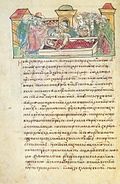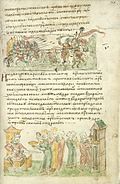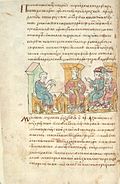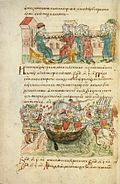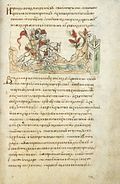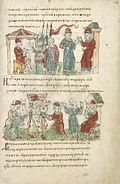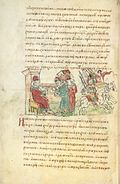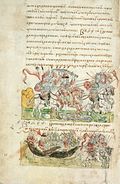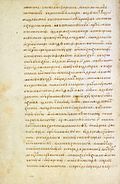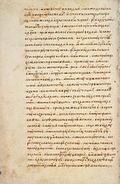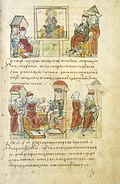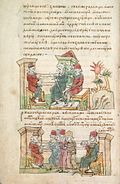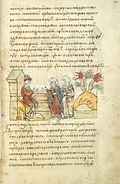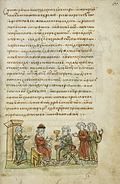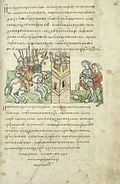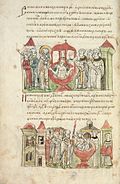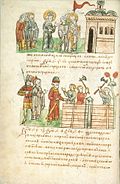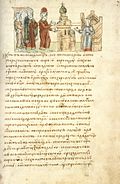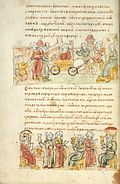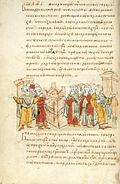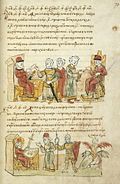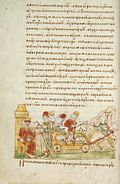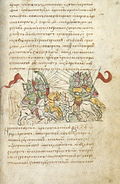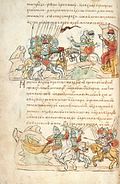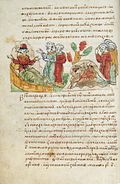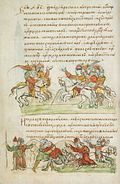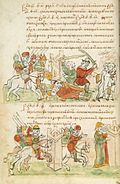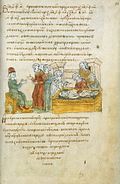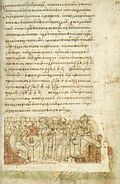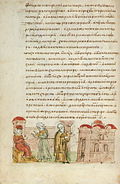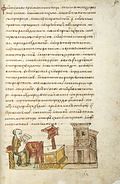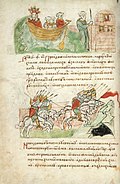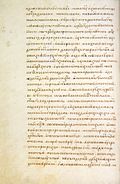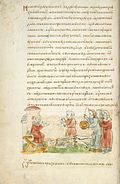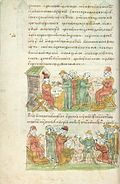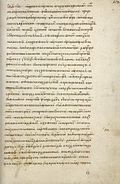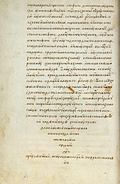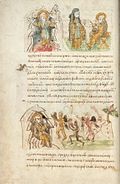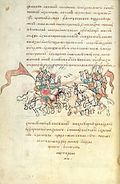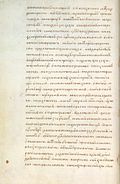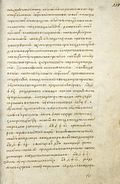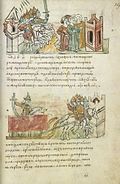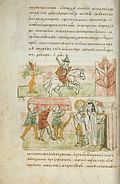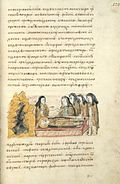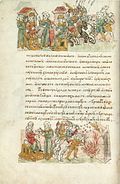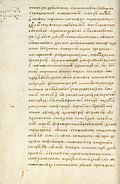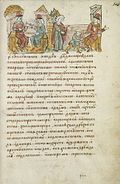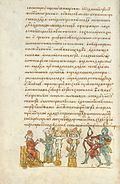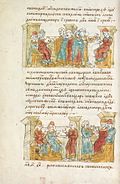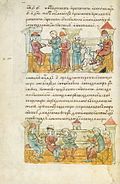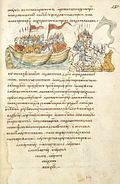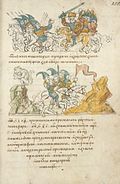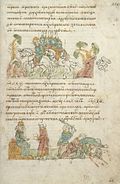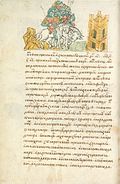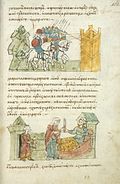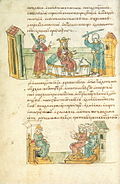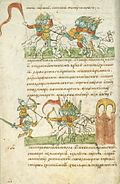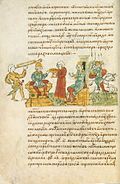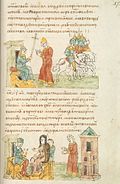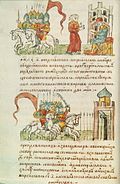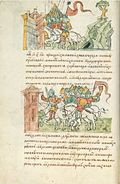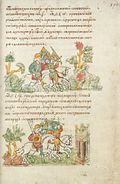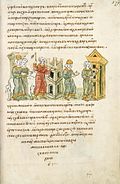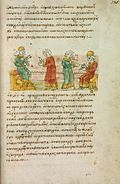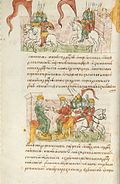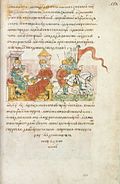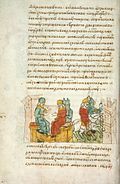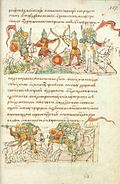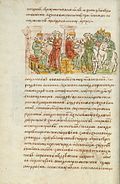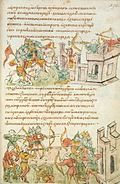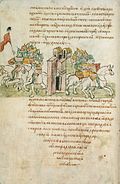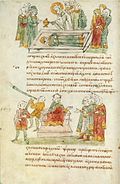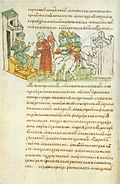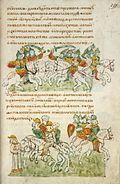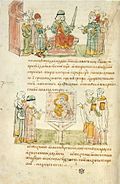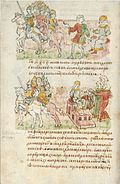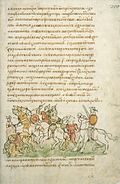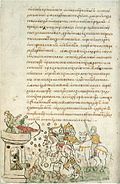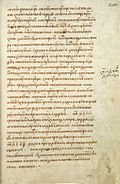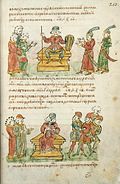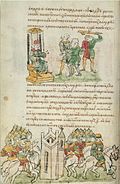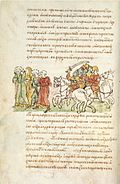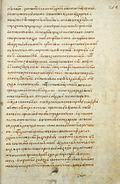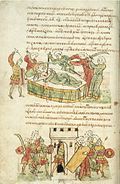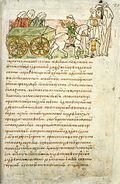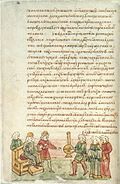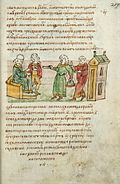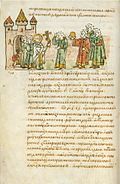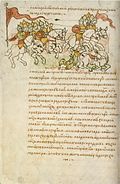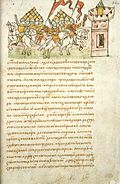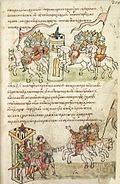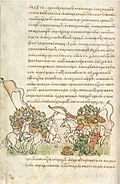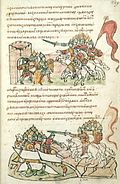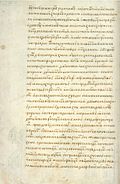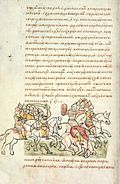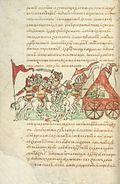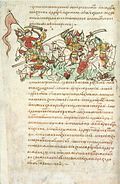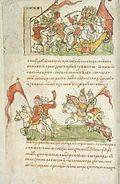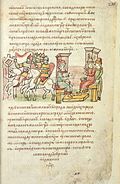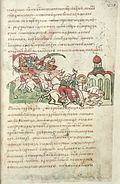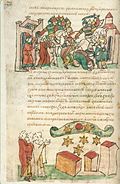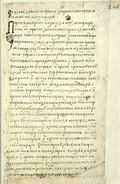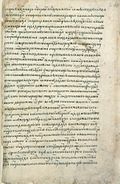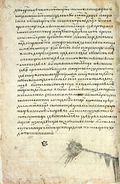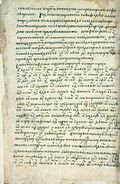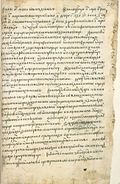You can help expand this article with text translated from the corresponding article in Russian. (March 2020) Click [show] for important translation instructions.
|
You can help expand this article with text translated from the corresponding article in Ukrainian. (May 2023) Click [show] for important translation instructions.
|

The Radziwiłł Chronicle, also known as the Königsberg Chronicle,[1] is a collection of illuminated manuscripts from the 15th-century; it is believed to be a copy of a 13th-century original. Its name is derived from the Radziwiłł family of the Grand Duchy of Lithuania (later, the Polish–Lithuanian Commonwealth), who kept it in their Nesvizh Castle in the 17th and 18th centuries. The Radziwiłł manuscript was taken out of Königsberg in 1761 and acquired by the Library of the Russian Academy of Sciences, Saint Petersburg, where it is currently preserved with registration number "34.5.30".[1][2]
The work tells the history of Kievan Rus' and its neighbors from the fifth to the early 13th centuries in pictorial form, representing events described in the manuscript with more than 600 colour illustrations.[citation needed] Among East Slavic chronicles, the Radziwiłł is distinguished for the richness and quantity of its illustrations, which may derive from the 13th-century original.[citation needed]
Contents
[edit]The Radziwiłł Chronicle (Rad.) has the following textual structure:
- a copy of the Primary Chronicle (Povest' vremmenykh let' (PVL), "Tale of Bygone Years") until the year 1116, the text of which groups it with the Laurentian Codex (Lav.), the Academic Chronicle (Aka.), and the remnants of the lost Trinity Chronicle (Tro.);[3][4]
- a text similar to the Kievan Chronicle from 1118 to the mid-1170s, also known as the "southern Rus' source" (sometimes considered part of the Suzdalian Chronicle in the broadest sense[5]);
- a copy of the Suzdalian Chronicle from the mid-1170s to 1203, the text of which has been very similarly preserved in the Laurentian Codex (Lav.), the Academic Chronicle (Aka.), and the Chronicler of Pereyaslavl-Suzdal (LPS); and[6]
- a continuation from 1203 until the year 1206; a virtually identical continuation for 1203–1206 has preserved in the Academic Chronicle (Aka.).[6] This text is based on records of the city of Vladimir on the Klyazma.[7]
- Primary Chronicle (PVL)
- Southern Rus' sources (similar to Kievan Chronicle)
- Suzdalian Chronicle
- Laurentian continuation of the Suzdalian Chronicle
- Radziwiłł Chronicle continuation of the Suzdalian Chronicle
- Sofia First Chronicle (S1L)
- Tver Codex of 1305
- lost leaves of surviving manuscripts
Gallery
[edit]-
Novgorod Slavs building Novgorod
-
Saint Andrew's prophecy of the rise of Kiev
-
Igor of Kiev levying tribute from the Drevlians
See also
[edit]References
[edit]- ^ a b c Tolochko 2016.
- ^ Maiorov 2018, p. 325.
- ^ Gippius 2014, pp. 342–343.
- ^ Thuis 2015, p. 249.
- ^ Butler 2012, p. 335.
- ^ a b Timberlake 2000, p. 239.
- ^ Thuis 2015, p. 287.
Bibliography
[edit]Primary sources
[edit]- Iroshnikov, M. P.; Kukushkina, M. V.; Lurie, Y. S. (1989). Том Тридцать Восьмой: Радзивиловская Летопись [Volume Thirty-Eight: Radziwiłł Chronicle]. Complete Collection of Russian Chronicles (PSRL). M. D. Priselkov, O. P. Likhacheva, R. M. Mavrodina, E. K. Piotrovskaya. Leningrad (Saint Petersburg): Nauka. p. 179.
Literature
[edit]- Butler, Francis (2012). "The "Legend of Gorislava" (not "Rogned'" or "Rogneda"): An Edition, Commentary, and Translation". Dubitando: Studies in History and Culture in Honor of Donald Ostrowski (PDF). Bloomington: Slavica Publishers. pp. 335–352. ISBN 9780893574048. Retrieved 31 March 2024.
- Gippius, Alexey A. (2014). "Reconstructing the original of the Povesť vremennyx let: a contribution to the debate". Russian Linguistics. 38 (3). Springer: 341–366. doi:10.1007/s11185-014-9137-y. JSTOR 43945126. S2CID 255017212. Retrieved 17 May 2023.
- Maiorov, Alexander V. (November 2018). ""I Would Sacrifice Myself for my Academy and its Glory!" August Ludwig von Schlözer and the Discovery of the Hypatian Chronicle". Russian History. 45 (4). Brill: 319–340. doi:10.1163/18763316-04504002. JSTOR 27072372. Retrieved 19 May 2023.
- Thuis, Hans (2015). Nestorkroniek. De oudste geschiedenis van het Kievse Rijk (in Dutch). Nijmegen: Uitgeverij Vantilt. p. 304. ISBN 9789460042287.
- Timberlake, Alan (2000). "Who Wrote the Laurentian Chronicle (1177–1203)?". Zeitschrift für Slavische Philologie. 59 (2). Universitätsverlag WINTER: 237–265.
- Tolochko, Oleksiy (2016-09-13), "Radziwiłł Chronicle", Encyclopedia of the Medieval Chronicle, Brill, retrieved 2022-01-13
External links
[edit] Media related to Radzivill Chronicle at Wikimedia Commons
Media related to Radzivill Chronicle at Wikimedia Commons- http://www.unesco.org/webworld/mdm/visite/radzivill/en/present1.html







